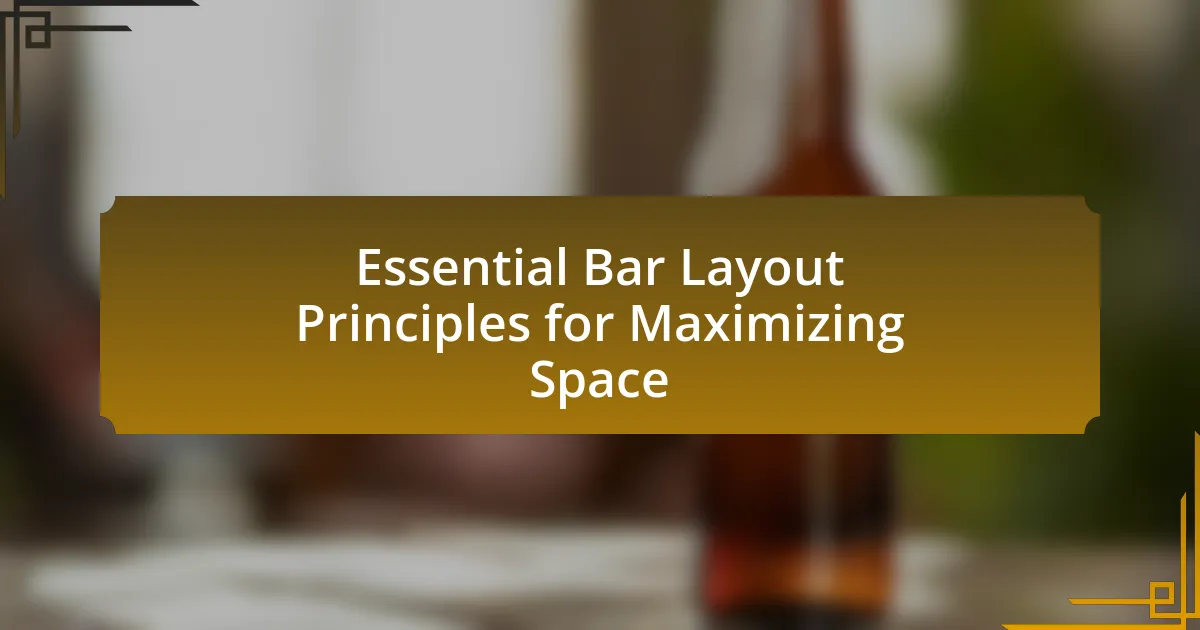The article focuses on essential bar layout principles for maximizing space, emphasizing the importance of efficient use of vertical and horizontal areas, strategic furniture placement, and clear pathways for movement. It discusses how these layout principles impact customer experience by enhancing accessibility, comfort, and social interaction, ultimately driving revenue and customer satisfaction. Key components of an effective bar layout, such as optimal bar counter design, seating arrangements, and storage solutions, are explored, along with strategies to avoid common design mistakes that can lead to overcrowding and inefficiency. The article provides practical tips for maximizing space, highlighting the financial benefits of an efficient layout and its influence on staff productivity.

What are the Essential Bar Layout Principles for Maximizing Space?
The essential bar layout principles for maximizing space include efficient use of vertical and horizontal areas, strategic placement of furniture, and clear pathways for movement. Efficient use of vertical space can be achieved through shelving and hanging storage, which allows for more items to be stored without occupying floor space. Strategic placement of furniture, such as bar stools and tables, should facilitate social interaction while ensuring that patrons can move freely. Clear pathways are crucial for both staff and customers to navigate the bar easily, minimizing congestion and enhancing the overall experience. These principles are supported by design studies that emphasize the importance of flow and accessibility in hospitality environments, demonstrating that well-planned layouts can increase customer satisfaction and operational efficiency.
How do bar layout principles impact customer experience?
Bar layout principles significantly impact customer experience by influencing accessibility, comfort, and social interaction. A well-designed bar layout facilitates easy movement for both customers and staff, reducing wait times and enhancing service efficiency. For instance, placing the bar counter in a central location allows patrons to engage with bartenders and other customers, fostering a lively atmosphere. Research indicates that bars with open layouts and clear sightlines can increase customer satisfaction by 20% due to improved social dynamics and reduced congestion. Additionally, strategic seating arrangements can enhance comfort and encourage longer stays, which is linked to increased spending. Thus, effective bar layout principles are crucial for optimizing customer experience and driving revenue.
What elements of layout contribute to a positive atmosphere?
Elements of layout that contribute to a positive atmosphere include spatial arrangement, lighting, color schemes, and furniture placement. Spatial arrangement ensures that patrons can move freely, promoting comfort and social interaction. Effective lighting creates an inviting ambiance; for instance, warm lighting can enhance relaxation, while brighter lights can energize the space. Color schemes influence mood; studies show that colors like blue and green can evoke calmness, while warmer colors can stimulate conversation. Finally, strategic furniture placement encourages social engagement and maximizes space efficiency, allowing for both intimate gatherings and larger groups.
How does layout influence customer flow and service efficiency?
Layout significantly influences customer flow and service efficiency by determining how easily customers can navigate the space and access services. A well-designed layout minimizes congestion and enhances the speed of service delivery, which is crucial in high-traffic environments like bars. For instance, research indicates that layouts that facilitate direct paths to service points can reduce wait times by up to 30%, thereby improving overall customer satisfaction. Additionally, strategic placement of seating and service areas can optimize staff movement, allowing for quicker response times and better service quality.
Why is maximizing space important in bar design?
Maximizing space in bar design is crucial for enhancing customer experience and operational efficiency. Efficient use of space allows for optimal seating arrangements, which can increase capacity and revenue while ensuring that patrons feel comfortable and not overcrowded. According to a study by the National Restaurant Association, well-designed layouts can improve customer flow and reduce wait times, leading to higher satisfaction and repeat business. Additionally, maximizing space facilitates better staff movement, which can enhance service speed and overall productivity.
What are the financial benefits of an efficient bar layout?
An efficient bar layout significantly enhances financial performance by optimizing space utilization and improving service speed. This layout minimizes the distance staff must travel to serve customers, leading to quicker order fulfillment and increased table turnover rates. Research indicates that bars with well-designed layouts can increase sales by up to 20% due to improved customer flow and satisfaction. Additionally, an efficient layout reduces labor costs by allowing fewer staff to manage higher volumes of customers effectively, thus maximizing profit margins.
How does space optimization affect staff productivity?
Space optimization significantly enhances staff productivity by creating a more efficient and organized work environment. When space is utilized effectively, employees can access tools, resources, and colleagues more easily, reducing time spent on unnecessary movements and increasing focus on tasks. Research indicates that well-designed workspaces can improve employee performance by up to 20%, as they foster collaboration and communication while minimizing distractions. For instance, a study by the International Journal of Environmental Research and Public Health found that optimized layouts lead to higher job satisfaction and lower stress levels, which directly correlate with increased productivity.

What are the key components of an effective bar layout?
An effective bar layout includes key components such as a well-defined bar area, efficient workflow design, strategic seating arrangements, and adequate storage solutions. The bar area should be centrally located to facilitate easy access for both staff and customers, promoting a smooth service flow. Efficient workflow design minimizes movement by placing frequently used items within reach, which enhances service speed and reduces wait times. Strategic seating arrangements, including a mix of high-top tables, booths, and bar stools, cater to different customer preferences and maximize occupancy. Adequate storage solutions, such as shelving and under-bar storage, ensure that supplies are organized and easily accessible, contributing to operational efficiency. These components collectively enhance customer experience and operational effectiveness in a bar setting.
How should the bar counter be designed for optimal use?
The bar counter should be designed with an ergonomic height, ample surface area, and efficient workflow in mind for optimal use. An ergonomic height, typically between 40 to 42 inches, allows bartenders to work comfortably while serving customers. A surface area of at least 24 inches deep provides enough space for drink preparation and customer interaction. Additionally, incorporating a well-planned workflow, including designated areas for mixing, serving, and storage, enhances efficiency. Research indicates that a well-designed bar counter can increase service speed by up to 30%, improving customer satisfaction and overall bar performance.
What dimensions are ideal for a bar counter?
The ideal dimensions for a bar counter are typically 42 inches in height and 24 to 30 inches in depth. A height of 42 inches allows for comfortable standing while serving drinks, aligning with standard bar stool heights. The depth of 24 to 30 inches provides sufficient space for patrons to place drinks and food without overcrowding. These dimensions are supported by industry standards, which suggest that a bar counter should accommodate both functionality and comfort for users.
How can the bar counter design enhance service speed?
Bar counter design can enhance service speed by optimizing workflow and minimizing movement for staff. A well-designed bar counter incorporates features such as strategically placed equipment, adequate space for multiple staff members to work simultaneously, and clear organization of supplies. For instance, placing frequently used items within easy reach reduces the time bartenders spend searching for tools or ingredients, thereby increasing efficiency. Research indicates that efficient bar layouts can reduce service time by up to 30%, as staff can serve customers more quickly when they have everything they need at hand.
What role do seating arrangements play in maximizing space?
Seating arrangements play a crucial role in maximizing space by optimizing the layout to accommodate more patrons while ensuring comfort and accessibility. Effective seating configurations, such as using modular furniture or arranging tables in a way that allows for easy movement, can increase capacity without overcrowding. For instance, a study by the American Institute of Architects indicates that strategic seating layouts can enhance the flow of foot traffic, leading to a more efficient use of available space. This approach not only maximizes the number of seats but also improves the overall customer experience, making it essential for bar layouts aiming to utilize space effectively.
What types of seating are most space-efficient?
The most space-efficient types of seating are bar stools and stackable chairs. Bar stools utilize vertical space and can be tucked under counters, allowing for more floor area. Stackable chairs can be easily stored when not in use, maximizing available space during peak hours. According to a study by the American Institute of Architects, using bar stools can increase seating capacity by up to 30% in limited areas compared to traditional dining chairs.
How can seating arrangements encourage social interaction?
Seating arrangements can encourage social interaction by facilitating proximity and creating comfortable spaces for conversation. For instance, circular or semi-circular seating layouts promote face-to-face engagement, which is essential for effective communication. Research indicates that environments designed with flexible seating options, such as movable chairs and communal tables, enhance social dynamics by allowing individuals to easily join or leave conversations. A study published in the Journal of Environmental Psychology found that open seating arrangements significantly increased the frequency of social interactions among participants, demonstrating that thoughtful seating design can directly influence social behavior.

What strategies can be employed to maximize bar space effectively?
To maximize bar space effectively, implement vertical storage solutions, such as shelving and wall-mounted racks, to utilize overhead space. This strategy allows for the organization of bottles, glassware, and tools, freeing up counter space for service and preparation. According to the National Restaurant Association, optimizing vertical space can increase storage capacity by up to 30%, enhancing operational efficiency and improving customer service. Additionally, using multi-functional furniture, like bar carts or collapsible tables, can further maximize space by providing flexibility in layout and accommodating varying customer volumes.
How can vertical space be utilized in bar design?
Vertical space in bar design can be utilized by incorporating shelving, hanging elements, and multi-level seating arrangements. Shelving allows for the display of liquor bottles and glassware, maximizing visibility and accessibility while also creating an aesthetic appeal. Hanging elements, such as pendant lights or decorative installations, draw the eye upward, enhancing the overall ambiance and making the space feel larger. Multi-level seating arrangements, including raised platforms or tiered seating, can create distinct areas within the bar, optimizing the use of vertical space and improving customer flow. These strategies not only enhance functionality but also contribute to a visually engaging environment, which is crucial for attracting and retaining patrons.
What are the best practices for shelving and storage?
The best practices for shelving and storage in a bar layout include utilizing vertical space, organizing items by frequency of use, and ensuring easy accessibility. Vertical space can be maximized by installing shelves that reach the ceiling, allowing for more storage without occupying additional floor space. Organizing items by frequency of use ensures that the most commonly used bottles and tools are within easy reach, improving efficiency during service. Additionally, ensuring that shelves are easily accessible prevents accidents and saves time, as staff can quickly find what they need. These practices are supported by industry standards that emphasize efficiency and safety in bar operations.
How can decor be used to enhance vertical space without clutter?
Decor can enhance vertical space without clutter by utilizing tall shelving units and wall-mounted decor. Tall shelving units draw the eye upward, creating an illusion of height, while wall-mounted decor, such as art or mirrors, can reflect light and expand the perceived space. Additionally, using vertical planters or hanging plants can add greenery without occupying floor space, further emphasizing verticality. This approach is supported by design principles that advocate for vertical lines to create a sense of openness and airiness in a room.
What layout configurations are most effective for different bar types?
The most effective layout configurations for different bar types include linear, L-shaped, U-shaped, and circular designs. Linear layouts are ideal for narrow spaces, allowing for efficient movement and service, while L-shaped configurations maximize corner areas, providing distinct zones for socializing and service. U-shaped layouts enhance interaction among patrons and staff, making them suitable for larger venues. Circular designs promote a communal atmosphere, often used in cocktail bars to encourage social engagement. Each configuration aligns with specific operational needs and customer experiences, supported by industry standards that emphasize flow and accessibility in bar design.
How does a pub layout differ from a cocktail bar layout?
A pub layout typically features a more casual and spacious design, accommodating larger groups with communal seating and a focus on social interaction, while a cocktail bar layout emphasizes a more intimate atmosphere with smaller tables and a bar-centric design for personalized service. Pubs often include features like pool tables or dartboards, enhancing the social experience, whereas cocktail bars prioritize aesthetics and mixology, often showcasing the bar as a focal point. This distinction is supported by industry trends indicating that pubs cater to a broader audience seeking a relaxed environment, while cocktail bars attract patrons looking for a refined drinking experience.
What layout works best for outdoor bars?
The best layout for outdoor bars is a U-shaped or L-shaped configuration, as these designs facilitate efficient service and enhance social interaction among patrons. U-shaped layouts allow bartenders to serve customers from multiple sides, improving workflow and reducing wait times. L-shaped designs create distinct areas for seating and service, optimizing space while encouraging a lively atmosphere. Research indicates that layouts promoting interaction can increase customer satisfaction and retention, making these configurations particularly effective for outdoor settings.
What are some common mistakes to avoid in bar layout design?
Common mistakes to avoid in bar layout design include poor flow, inadequate space for staff movement, and neglecting customer sightlines. Poor flow disrupts service efficiency; for instance, a layout that forces bartenders to navigate around obstacles can slow down drink preparation. Inadequate space for staff movement can lead to congestion, making it difficult for employees to serve customers effectively. Neglecting customer sightlines can diminish the overall experience; if patrons cannot see the bar or entertainment areas, it may reduce their engagement and satisfaction. These mistakes can significantly impact operational efficiency and customer enjoyment.
How can poor layout choices impact customer satisfaction?
Poor layout choices can significantly diminish customer satisfaction by creating an uncomfortable and inefficient environment. When customers struggle to navigate a space due to poor design, it leads to frustration and a negative experience. For instance, a study by the Journal of Retailing found that 70% of customers reported leaving a store due to poor layout, indicating that layout directly influences their willingness to stay and engage. Additionally, inadequate spacing can lead to overcrowding, making customers feel rushed or claustrophobic, which further detracts from their overall experience. Thus, effective layout design is crucial for enhancing customer satisfaction and encouraging repeat visits.
What are the pitfalls of overcrowding in bar design?
Overcrowding in bar design leads to several significant pitfalls, primarily affecting customer experience and operational efficiency. When a bar is overcrowded, it can result in long wait times for service, which diminishes customer satisfaction and may deter patrons from returning. Additionally, overcrowding can create safety hazards, as it increases the risk of accidents and makes it difficult for staff to navigate the space effectively. Furthermore, overcrowded environments can lead to noise levels that are uncomfortable for guests, impacting their ability to socialize and enjoy their time. Studies indicate that optimal bar capacity should consider both comfort and safety, with recommendations suggesting a maximum occupancy that allows for easy movement and interaction among guests.
What practical tips can help in maximizing bar space?
To maximize bar space, implement vertical storage solutions such as shelves and racks. Utilizing vertical space allows for more efficient organization of bottles, glassware, and tools, reducing clutter on the bar surface. According to the National Restaurant Association, optimizing storage can increase operational efficiency by up to 30%, enabling bartenders to work more effectively in limited areas. Additionally, using multi-functional furniture, like bar carts or foldable tables, can further enhance space utilization by providing flexibility in layout and storage options.




